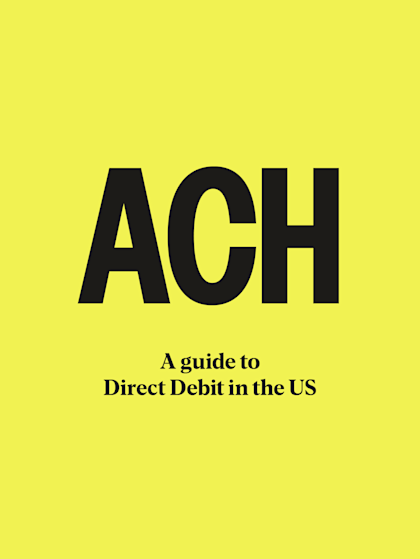
Cash, Checks and Bank Transfers vs. Direct Debit
Last editedApr 20231 min read
A comparison of Direct Debit and cash, checks, and bank transfers.
Many businesses accept regular payments by checks, cash, or bank transfer. Increasingly, however, many are turning to Direct Debit because it is simpler and cheaper.
Cash and checks
Checks are the traditional method for collecting regular and one-off payments.
A check is a document, written and signed by a customer, instructing a bank or similar entity to debit your account and pay another person or organization. A check can take several working days to clear.
If they pay you by cash or check, your customers have full control over when and how much they pay.
How to collect Direct Debit payments with GoCardless
1.
Create your free GoCardless account, access your user-friendly payments dashboard & connect your accounting software (if you use one).
2.
Easily set up & schedule Direct Debit payments via payment pages on your website checkout or secure payment links.
3.
From now on you'll get paid on time, every time, as GoCardless automatically collects payment on the scheduled date. Simple.
Bank transfers
A bank transfer - which could be a wire transfer or an ACH payment - is a service which enables people or organizations to make payments directly from their bank account into another bank account. Learn more in our guide to wire transfers vs. ACH transfers.
Bank transfers are typically used by organizations to pay salaries, pensions, state benefits and tax credits, but like cash and checks, they can also be used by customers for one-off payments. Customers have full control over when and how much they pay through these methods.
Bank transfers take different amounts of time to settle, depending on the type. Wire transfers typically arrive the same day, while ACH transfers can take several days.
Direct Debit
Direct Debit - also known as ACH Debit or bank debit - is an authorization from your customer that enables you to take regular payments from their bank account. Direct Debit payments can vary in frequency and amount, so you can collect however much you need to, when you need to.
Cash, checks, and bank transfers vs. Direct Debit - A comparison
To help you make the right decision for you, here is a summary of the differences between cash, checks, bank transfers, and Direct Debit:
| Cash, checks, bank transfers | Direct Debit | |
|---|---|---|
| Cost per payment | Low - High. Depends on method. | Low. Depends on provider. (See our pricing) |
| Failure rates and notifications | Low – None. Cash: None. Checks / bank transfers: Low. You will not be notified of failures. | Very low. < 1% with GoCardless. Automatic notification. You are notified automatically of failures and can re-submit the payment when you want to. |
| Flexibility of payments | Low. You will need to convince customers to make any changes to their payments themselves. | High. You can collect variable amounts, or change the amount or date of payments, without asking customers for further authorization. |
| Risk of late payment | High. You are dependent on customers remembering and choosing to pay on time. | Low. You can collect a payment whenever it is due. |
| Admin required |
High.
|
Very low.
|
| Customer protection | Low. Once payments are made, no refunds. | High.Refunds from your bank in the event of an incorrect charge (subject to ACH customer protection rules). |
Which payment method is right for me?
Cash, checks, or bank transfers
You should use cash, checks, or bank transfers if:
You have very few customers to keep track of
You are mainly collecting one-off payments
You want to collect high-value payments (and want to avoid paying transaction fees on these)
Direct Debit
You should use Direct Debit if:
You are taking regular payments
You don't need payments to arrive instantly
You have many customers to keep track of and want to reduce admin time
To find out more about using Direct Debit to collect payments, check out our 60 second guide to accessing the Direct Debit scheme.

